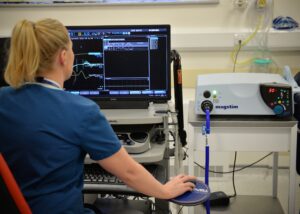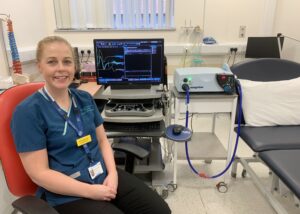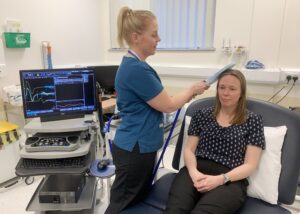


In the UK, there’s a large group of patients with compression of their spinal cord – otherwise known as degenerative cervical myelopathy – and this causes long term damage to the spine.
With the number of people with this condition ever increasing, Diane Boothman, a clinical scientist and Somerset NHS Foundation Trust’s clinical service manager for neurophysiology, is seeking to find out whether brain stimulation can be used to diagnose spinal damage, as part of the doctorate she’s studying for.
The research that Diane is carrying out involves looking at the effectiveness of transcranial magnetic stimulation, more commonly known as brain stimulation, in degenerative spinal myelopathy.
It all came about after Diane signed up to the national Higher Specialist Scientist Training programme, which is run through the National School of Healthcare Science.
She explains the problem that colleagues face when diagnosing degenerative spinal myelopathy.
“When our spinal team see a patient with signs and symptoms of spinal myelopathy, they’ll be sent for an MRI scan that often clearly indicates a problem, but the patient doesn’t necessarily have the right level of symptoms for a diagnosis or to be listed for surgery,” said Diane.
“At the same time, there’s also another group of patients who have clear symptoms of the condition, but the MRI scan doesn’t quite meet the criteria for a diagnosis.
“For these patients, an operation may appear the only option, but as the MRI scan isn’t clear enough, we can’t be entirely certain that surgery will work. The other option involves waiting until the symptoms get worse, which again isn’t ideal for the patient.”
As part of her research, Diane looked into whether transcranial magnetic stimulation could work as an additional diagnostic tool for the condition.
She continued: “When I looked at the literature review on this subject, it was clear that different techniques were being used across the world. It really wasn’t standardised, but as the number of patients being diagnosed with transcranial magnetic stimulation was so small, it simply wasn’t robust enough to routinely use in clinical practice yet.
“The patients being recruited for the study will generally come in following a referral from their GP into our orthopaedic assessment service, which triages them for the spinal surgery service.
“They’ll have symptoms of myelopathy, and once identified, our surgeons will let the patient know about the research study, before contacting me or Steph (my secretary) so I can follow up with them within a couple of weeks to see whether they’re interested in joining the study.
“If they decide to join the study, then I’ll give them an appointment and they’ll come into our neurosciences department at Musgrove Park Hospital, where we’ll go through a risk assessment and safety checklist.
“Then they’ll have neurological examinations for their reflex and strength – and two clinical questionnaires; one called modified Japanese orthopaedic assessment, and another called neck disability index – both of which give a score on how the patient’s symptoms affect them on a daily basis.
“It’s really important to not just have physiological measures, but we must also take into account their quality of life, as they may score badly on a clinical test, but their condition isn’t really bothering them that much, and that should inform their care.
“I’ll then carry out the transcranial magnetic stimulation, with specific measures that will give us the required data needed to have a better understanding of whether it can work as a diagnostic tool.
“The transcranial magnetic stimulation treatment involves placing a big coil over the patient’s skull, before we check two different muscles in their forearm, hand, shin and foot, which records how fast the signal travels through their spinal cord.
“The surgeons will use MRI to look at the physical structure of the spine and whether there’s anything pushing into it, and the scans, along with the clinical examination, will bring them to a diagnosis.
“We will test all the patients who have a definite diagnosis of degenerative cervical myelopathy with the transcranial magnetic stimulation, to see if the our test agrees with the surgical diagnosis.
“The great thing about the transcranial magnetic stimulation treatment is that there are no side effects, and the patient can go home straight after it.
“As part of my study, I’ve spoken with our patient engagement team to get the viewpoint of our patients on my research proposal, to check whether they feel it would be useful for them.
“I’ve also worked closely with our research department and information team, as well as our data scientists and governance team.”
Diane said she’s excited to begin the study in the coming months, and feels it could prove a gamechanger when it comes to the treatment of patients with degenerative spinal myelopathy.
“I’m hoping that if the transcranial magnetic stimulation works and proves useful, then we can integrate it into the regular way we diagnose the condition,” she continued.
“We don’t know yet whether we can use it to give a firm diagnosis for all patients with myelopathy, but I’m really hoping that we’ll be able to use it for those patients who come into clinic through with suspected myelopathy, as we should then have enough information for our surgeons to make a diagnosis.
“If that works, then it’ll either mean that patients are not left suffering unnecessarily, and it might even avoid unnecessary operations altogether.”
How you can join the study (even if you don’t have suspected myelopathy!)
Diane continued: “I need 400 patients to join the study, half of whom have symptoms of myelopathy and will be recruited from the spinal clinic and the other half without those symptoms – who could be absolutely anyone as long as they’re over 18.
“This group of so-called ‘normals’ are used as reference data so I can compare the two groups, so I’d encourage everyone to consider taking part – all you need to have is a quick transcranial magnetic stimulation session and you’ll be contributing to clinical research!
“There is an exclusion criteria, so people with a pacemaker or those with epilepsy, for example, won’t be able to take part – we’ll ask those questions before you book an appointment.”
To take part or for more information, email MyelopathyResearch@SomersetFT.nhs.uk
